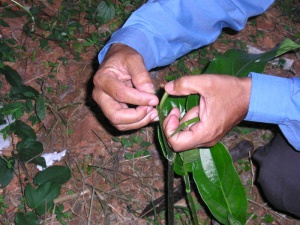Name : Ravishankar
District & State : Dakshin Kannada, Karnataka
Category : Plant varieties
Award : State
Award Function : 5th National Grassroots Innovation Awards
Award Year : 2009
Innovation Description
A marginal farmer, Ravishankar (46) has developed a root wilt resistant pepper variety simply by the way of grafting.
 Ravishankar lives with his wife and two young children in Shilpi Amdal house 5 km from Madhyanthar in Dakshina Kannada district. The region has undulating topography with dense forest cover. To the west of the region is the Arabian Sea while to the east is the Western Ghats. The region experiences ample rainfall throughout the year. The major commercial crops grown are arecanut, cardamom, vanilla, pepper, rubber, sugarcane, and banana while paddy being the only cereal crop.
Ravishankar lives with his wife and two young children in Shilpi Amdal house 5 km from Madhyanthar in Dakshina Kannada district. The region has undulating topography with dense forest cover. To the west of the region is the Arabian Sea while to the east is the Western Ghats. The region experiences ample rainfall throughout the year. The major commercial crops grown are arecanut, cardamom, vanilla, pepper, rubber, sugarcane, and banana while paddy being the only cereal crop.
Having studied till class ten, Ravishankar had to start practicing agriculture, as his parents could not afford his further studies. As he had been helping his father in agriculture since childhood, he had gained much knowledge about the same. At the age of 23, he took complete charge of the farm where today he grows coconut, arecanut, pepper, banana and cashew. Apart from agriculture, his interests also lie in doing mechanical things. He is a tinkerer and likes keeping himself engaged.
Identifying the disease
In 1996-97, he grew three pepper varieties viz. Panniyur, Karimunda and Vayanadu in his farm. But, due to a certain disease, the entire crop failed and he had to incur heavy losses. He recalled the turn of events and noted that first the color of the leaves turned yellow and then they fell off. Then the roots dried up and the stem discolored, resulting in the death of the plant. Initially he thought it to be because of root worms but was later told that it was the wilt disease. He then decided to find out a remedy for wilt disease in pepper.
Looking for a solution
Ravishankar had known about the process of grafting. He had also tried grafting on different weeds and developed his own variation of the method. He thought of using grafting as the easiest method to introduce disease resistance in pepper.
Hippali is a local spice and medicinally used to treat ailments like cough, cold, fever, etc. He checked out the plant and learnt that the roots of hippali were very strong in nature. The growth of the plant was vigorous; it was pest free and showed no disease incidence. It had a smell similar to that of pepper, which made him conclude that it might be related to pepper and hence could be used for grafting. He also recalled that of the three varieties in his field, Panniyur variety had the best yield and disease tolerance. Finally, he decided to develop a new plant through grafting of Hippali as stock and Panniyur as scion.
Developing the variety
Ravishankar took both plants of the same age and grafted them. He then planted 6 -7 grafted plants in his field. All the plantlets showed resistance to root wilt and grew healthy. These new plants, apart from being perennial, showed less harvesting period. The yield per plant was also comparable to the Panniyur variety plants in his farm. He also observed that after grafting the plants needed shade in order to increase their chance of successful growth. Flowering in all the plants was seen in the month of June and harvesting was done once a year. For better root growth, he encourages the use of V-notch method for grafting, which has to be done carefully.
The new variety
The new pepper variety is wilt resistant with high phenolic content. The number of spikes per plant is between 30-40 with the number of berries being 100-165. The dry yield is 1.5 kg/year/vine. The variety takes eight months to fruit after flowering and yields economically after two years. The root depth is between 60-90 cm, with the root volume being very high. Profuse aerial roots are another special character.
Scientists and experts from University of Agricultural Sciences, Bangalore and Agriculture Research Station, Thirthahalli visited Ravishankar’s farm to evaluate his variety. They compared the new variety with the locally popular Panniyur variety. It was found that the Phenolic content of the new variety was higher, which may be a reason for its wilt tolerance. The number of spikes (30-40 at the age of two years) was more than that in Panniyur (25-30 at the same age) as was the dry pepper yield (1.5kg./year/vine as compared to 1.0kg./year/vine in Panniyur variety). The time for first economic yield is lesser (two years) than the Panniyur variety (four years). The leaves are dark green in color and have high chlorophyll content (80 mg fresh wt.) as compared to Panniyur variety having moderately green colored leaves and low chlorophyll content (50 mg fresh wt.)
Other pursuits
Ravishankar, recently, has also made beehives from cement. During the rainy season, wooden hives get damaged quickly. Traditional bee hives face attacks from hornets also. The cement bee hive solves these problems. The heavy weight of the cement hive saves it from theft. They are better adapted to vagaries of weather like rain and sunlight. Unlike wood, cement also provides protection from termites, bush fires, worms and pests.
He has a small workshop made of scrap and junk where all his innovations take place. He also has ideas about using petromax for cooking, LPG operated scooter, organic food grain storage, fuel saving stove and numerous other things. His wife, Jyothi, though a simple housewife is also an innovator. She developed a multipurpose energy efficient utility stove, which captures the wasted radiated heat in a wood fired stove to simultaneously cook as well as heat water in a tall drum to a temperature of 80 degrees. For this innovation, she won a consolation award in NIF’s Third National Competition for Grassroots Innovations and Traditional Knowledge Practice in 2005. Same year, Ravishankar’s work also got published in Udayavani Kannadadaily and Nirantara Pragati.
Ravishankar’s experiences, with his innovations, have been good but not with the people who have had a chance to look at them. He laments the fact that most people do not understand his work. The interest in such activities is negligible and there is little motivation and support available for people like him. But he is hopeful that with better work, the perceptions of people will change and many will come forward to support such creative initiatives.
